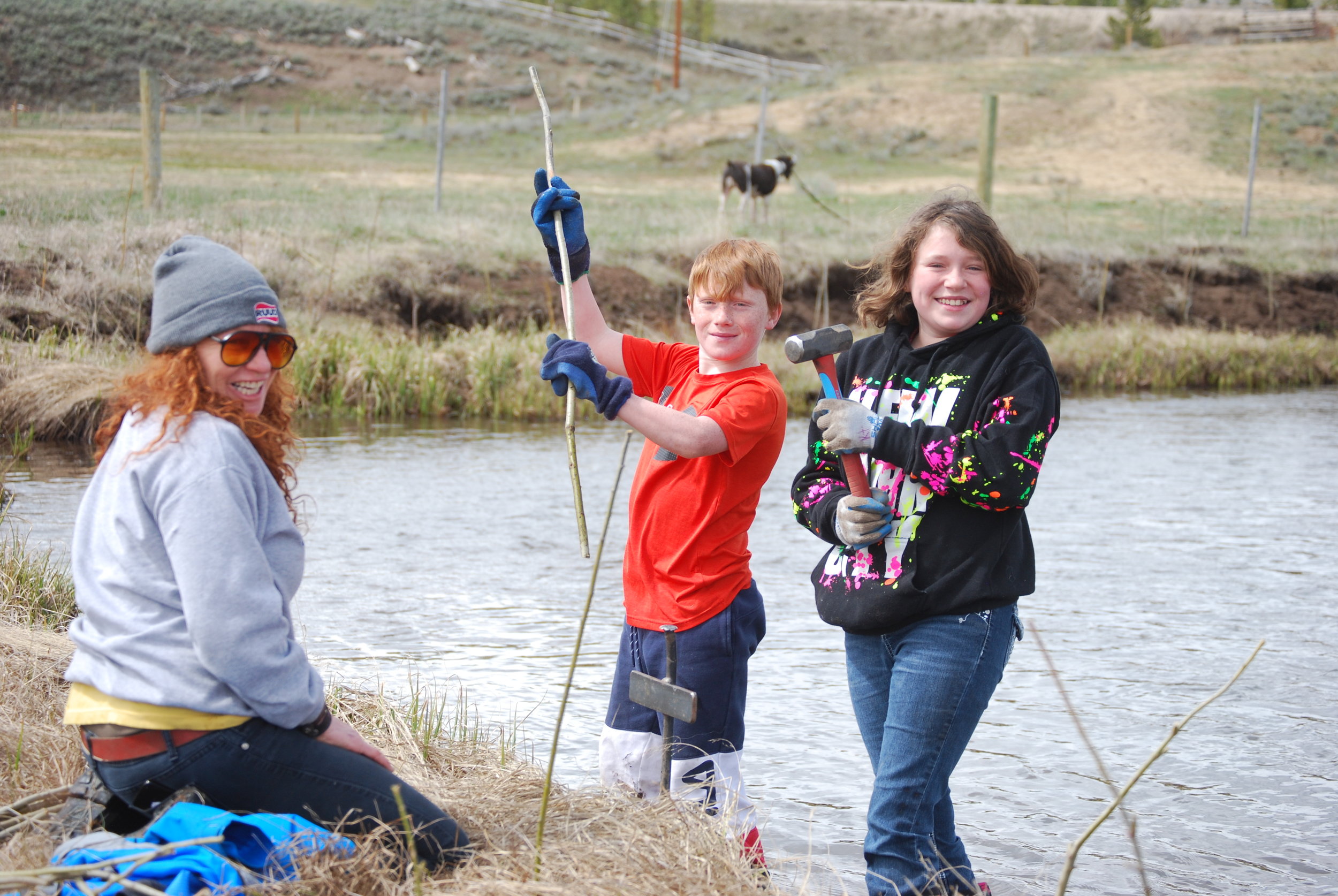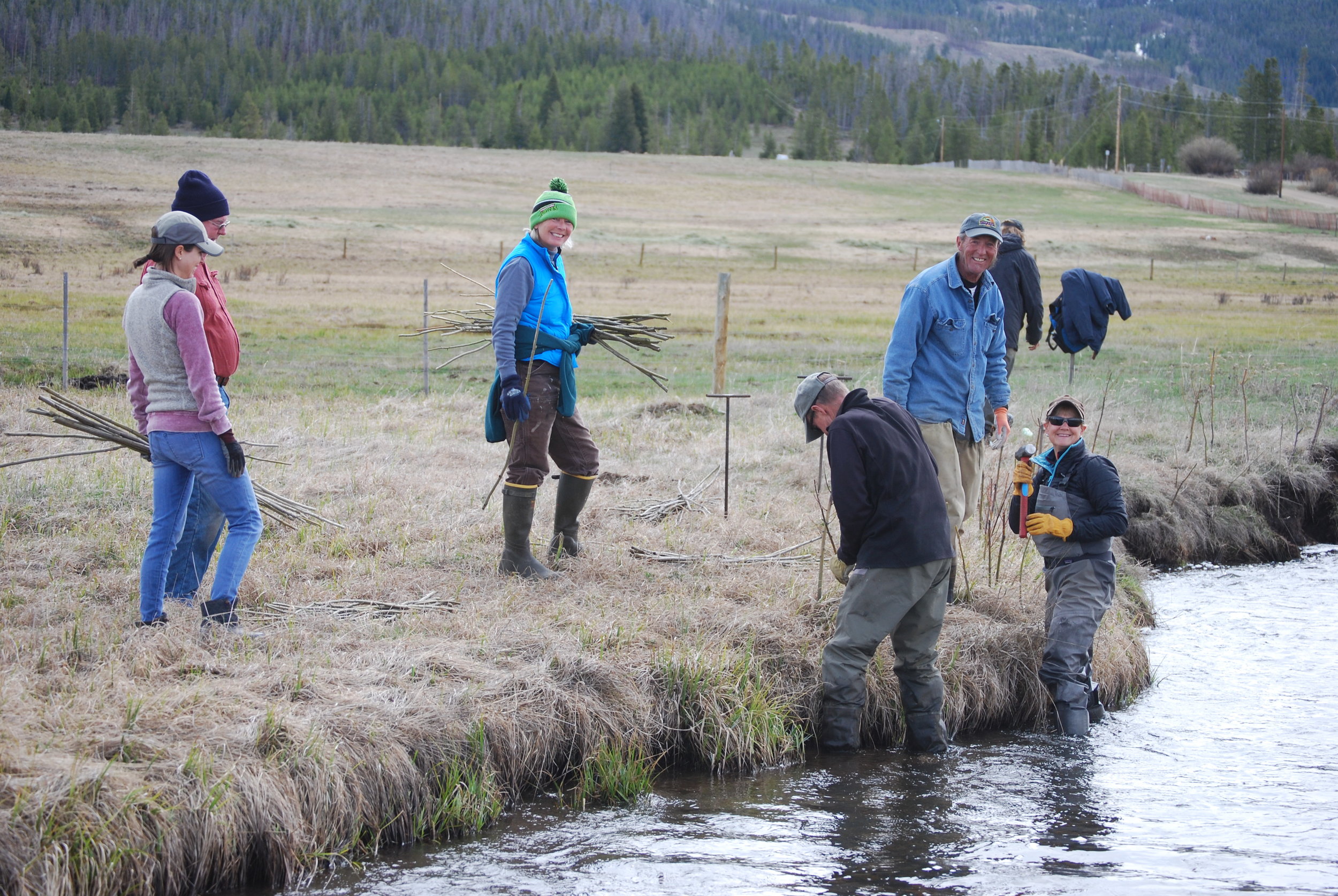Mother Nature Needs Our Help August 5
By Kirk Klancke
Years after the East Troublesome fire swept through our county, the devastation continues to haunt us. Trout Unlimited has concerns over the loss of willows which stabilize stream banks and work as a filter for the river to keep debris and ash from getting into our streams in the impacted area.
Willow Creek was one of the hardest hit riparian areas in our county and the loss of those willows is causing severe environmental harm to the creek. This spring the C Lazy U Ranch and the Headwaters Chapter of Trout Unlimited are teaming up to jumpstart the return of the lost willow habitat.
Trout Unlimited, with help from the C Lazy U Ranch and community volunteers, harvested willow stakes on Saturday July 22nd. The willow stakes that we harvested that day are kept in water until they start to grow a new root system. Then on Saturday, August 5th TU is organizing a day to plant the willow stakes in a damaged riparian area on the C Lazy U Ranch.
Volunteering to help with this fire recovery project will introduce you to other Grand County residents who share your conservation values and allow you to help in the healing process post East Troublesome fire. Make August 5th a day that you give back to the earth. Your mother will be proud.
To register to help click the Volunteer Form button below. We’ll provide lunch and endless entertainment.
Willow Planting:
Planting August 5
Volunteers Needed to Plant Willow Saplings
We need volunteers again this summer to assist in planting willow saplings for river restorations in the Colorado basin. Please see below and share as you see fit. Thank you so much!
Please come prepared for the day with water and as many of these other items as you can: mud boots, work gloves, outdoor gear, hat, and sunscreen. Pruning tools and lunch will be provided.
This summer, we’ll be harvesting and planting along Willow Creek on C Lazy U land off of County Road 125 near Granby.
Link to Sign Up:
Thanks again for your support!
Thanks so much for volunteering to help harvest willows for this important project to help mitigate damage from the Troublesome Fire. Please see the information below.
Start Time: 10:00 AM
Lunch will be provided and we will finish by 2:00 PM
Directions to site: Two mi. west of Granby turn on to Hwy 125. Go 4.2 mi. & turn right on to CR 407E thru a wooden gate with stone columns. Take immediate left and then immediate right. Continue for about 0.2 mi. (Turn is 0.6 mi. north of C Lazy U Ranch entrance and just past Road Mile 4.) If for some reason the gate is closed and you cannot get in, check w/Taylor Swift at the ranch. Questions? Call Dennis at (303) 506-4588
We will provide lunches, water, & soda. If you are old enough and do good work, a cold beer may be your reward. Remember to bring hat, rain gear, gloves and waders or water proof boots. Also, consider insect repellant and sunscreen.
Willow Project Still Responding to 2020 Fires
Typically each spring, we harvest, nurture and replant willow stakes to stabilize river banks and provide shade for a selected stretch of one of our local rivers. We continue to work with the Colorado Parks and Wildlife to target the areas where we can have the most impact.
Williams Fork Fire, Sept. 30. Photo by Jerry Nissen
Importance of Willow Planting for Stream Health
Willow planting 2019
Colorado Parks and Wildlife fisheries biologist, Jon Ewert believes that the restoration of healthy willow growth in burned areas is the best way to mitigate the impact of fire on our watershed.
Post fire, planting willows along streams helps reduce flow of ash and debris into streams, reduces erosion and stabilizes stream banks keeping water cleaner and healthy. Surprisingly, Ewert tells us that spring runoff is less of an issue than summer rainstorms for our streams post-fire. Under normal conditions, Ewert says willow planting does as much for the fishery as our stream channeling projects. Fish need willows for cover and to hold deep undercut stream banks together for fish habitat.
The Headwaters Chapter has planted over 7,000 willows in the last 3 years and scheduled another project for spring 2020 before Covid 19 forced us to cancel the planting. For 2021, we’ve learned how to undertake a willow harvesting and planting event safely, even if Covid 19 is still prevalent. A spring planting project when the water table is highest guarantees us our highest success rate. Please check in occasionally to see when our next project is happening so that you can help us quickly recover from the fires of 2020 and improve the health of the fisheries at the headwaters of the Colorado River.
Our chapter works hard to restore a healthy riparian environment.
One important part of our efforts centers on replanting willows in degraded areas.
Here are some tips for willow harvesting and planting.
Harvesting
The best time to harvest is in early spring when the twigs have fully formed buds but before the buds have opened and leaves have started coming out. Once they start leafing, that is where their energy is focused as opposed to the roots, which is what we want.
If one of the key objectives is shading, then harvest from the tallest willows in the area. You need not worry about species diversity. Many of the willows are hybrids anyway.
Do not worry about over harvesting from a single willow bush. They are durable.
Do not harvest whips, i.e., real skinny twigs, even if they have buds. The bottom end of the stake should be about ½ inches in diameter. If planted in the spring, a length of about 3’ is preferred. You want the stakes tall enough when planted to facilitate rate of growth, but not so tall as to be vulnerable to wind and high water flows.
Cut with sharp clippers. If they are dull, a chewed up cut on the bottom end can damage to the tissue that transports nutrients, etc., possible resulting in less success. Cut off any side branches.
The cut furthest from the tree trunk should be 90° (blunt), and the cut nearest to the trunk should be 45° (sharp point).
Each team should have someone appointed to collect the stakes as they are harvested, tie them into bundles of 25 using twine, make sure the sharp ends are all pointed in the same direction, and put the sharp ends (bottoms) into water ASAP. They also should keep track of how many bundles have been collected. The bottoms of the stakes can be laid in a stream or pond temporarily, and then put into pails with water. Leaders may need to demonstrate how to tie a good knot. This person should also examine every stake, and recut the bottom if necessary to ensure a clean cut, and they should toss away whips or stakes that are obviously dead (i.e., no green cambium peripheral tissue showing in the cuts).
Ideally, the pails should be kept cool and in the dark, with the bottoms of the stakes soaked for at least a week. However, if there is no place to store the pails, stakes can be weighted down in water and soaked for a couple of days and then planted and even stored in snow banks.
Let everyone know where people can access a first aid kit, and have them report any injuries to the Leaders. Encourage them to drink water and wear gloves on the clipper hand.
Planting
Prepare a hole at least a foot deep with rebar or a metal stake that is 5/8ths or ¾ inches in diameter. It is important that the stake be planted in soils that are and will be soaked or moist for at least the first month after planting. (Look at the bottom of the stake for clues.)
If you cannot plant that deep, you need to cut off the top of the stake so only a foot or less is exposed to help reduce loss to runoff flows.
Try to keep the sharp ends of the stake moist and in the shade until planted. Use of wetted gunny sacks in hot weather can be helpful.
Place the stake in the hole with the sharp end down. It helps to recut the bottom end if they have been soaking in water for several days so that fresh cambium tissue will be exposed to the moist soils. In very soft soils, willow stakes that are larger in diameter can be slowly pressed into the ground, but do not force it too much. Be careful not to damage the tissue on the bottom of the stake on rocks, etc.
Tamp the soil closely to the planted stake. It is important to reduce the amount of air that can access the bottom of the stake to help prevent fungus and pests from causing a problem.
In an area of heavy use, you may wish to flag the stakes so they are not accidentally stomped on. Speaking of which, excluding livestock is very important.
Return to the site a month later and take pride in your contribution to sound stream management. Wet a line if permitted.



